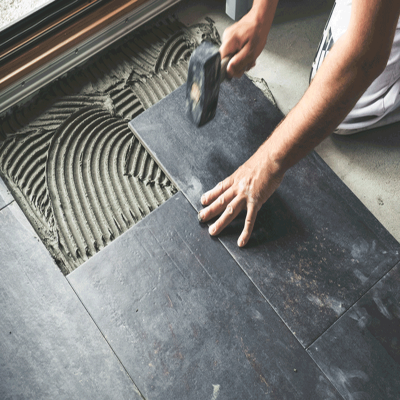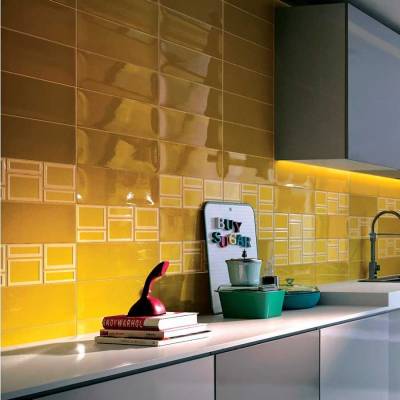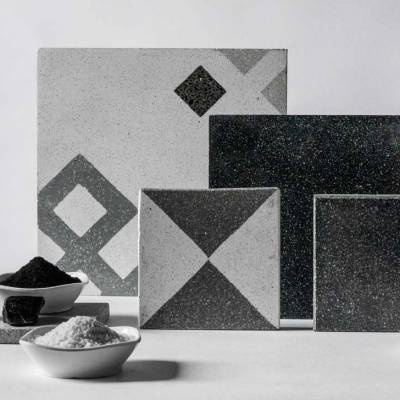- Home
- Building Material
- Tiles
- Transformational Tiles

Transformational Tiles
Flooring in India will have you, well, floored. The industry has changed beyond recognition in the past few decades with the advent of new materials, technologies and specialised machinery. The shift towards tile flooring has played a significant role in this flooring revolution. Today, tiles play a major role in defining interior and exterior spaces with other forms of flooring, like marble, granite, concrete and wood, taking a backseat. Tiles are also being used for walls in various internal and external applications.
This is not really surprising as tiles have an edge over others, aesthetically and functionally. Apart from being available in varying types, styles, shapes, sizes, colours and textures, they are also cost-effective. Today, tiles are available in stone, marble, wood, metallic, terrazzo and limestone textures, leading to the creation of interesting and exciting designs. Further, technologies like digital imaging and ink-jet printing have transformed the look of ordinary tiles.´The Indian tile industry is evolving with the digital technology. Gone are the days when consumers felt that Italian and Spanish tiles were superior. Today, Indian manufacturers are using the same technology and are able to produce tiles of international standards,´ states Atul Sanghvi, Executive Director, CERA Sanitaryware Ltd, which offers a full range of floor tiles - from PGVT (digital printed polished glazed vitrified tiles) to double charged tiles and soluble salt tiles in different dimensions for the floors as also tiles for specific purposes like exterior decorative cladding, parking area, etc.
From the functional angle too, tiles are more durable, easy to maintain and highly resistant to heat, moisture, spills and scratches. In addition, there are tiles with specific properties like anti-skid, germ-free, stain-resistant, anti-static, etc. Little wonder then, that tiles have become a much sought-after flooring solution for various sectors, including residential, retail, hospitality, health and office spaces.
Market movers Consequently, the Indian tiles market has been growing rapidly.´We are growing at an annual growth rate of 15 per cent,´ says Ashok Goyal, CEO, Nitco Ltd.´The market size of the Indian tile industry is Rs 24,500 crore as of March 2015. India´s ranking in the world ceramic tile production stands at number three; China and Brazil are the top two.´
A major player with a wide product range including ceramic, glazed vitrified tile, double charged, and heavy-duty tiles, the company recently launched NITCO Casa, an exclusive range of wall tiles.
Apart from Nitco, other lead players in the organised sector include HR Johnson, Somany Ceramics, Kajaria Ceramics, HSIL, Asian Granito, CERA, Orient Bell and RAK Ceramics. In addition, there are several imported brands, largely from Europe, available either directly or through tie-ups with Indian companies. At the other end is the unorganised sector, accounting for nearly 60 per cent of the total market.
Demand drivers
The industry´s growth drivers have been rapid urbanisation, the booming real estate sector, growing retail market, government initiatives and growing awareness and changing lifestyle perceptions among consumers.
“Passé are the days when décor used to be a secondary thought in the minds of the average consumer looking for affordable yet durable settings,´ says Abhishek Somany, Managing Director, Somany Ceramics.´Now, products with great designs and functional expertise have taken centre-stage in décor essentials in offices, malls, hotels and homes. Tiles are a versatile way of adding decorative yet useful embellishments to any living space. Today, we have a plethora of tiles suiting the ambience, different preferences, needs and financial capability of customers. Hence, tiles are increasingly being adopted as a cost-effective yet aesthetically appealing tool.´ The company offers a wide range of tiles including the recently launched Nano-polished vitrified tiles for dilapidated walls and floors, Slip Shield tiles that remain non-slippery even on wet surfaces, and Glosstra tiles powered by ultra gloss technology.
Meanwhile, Goyal lists the other factors behind the industry´s growth.´Growth has been largely owing to urbanisation, the booming retail industry, increase in disposable incomes and optimism in India´s economic outlook,´ he says.´In addition, the replacement cycle has shortened to once in eight to ten years compared to once or twice in a lifetime. Also, today, all major tile manufacturers have adopted an asset-light strategy for future growth, that is, a JV model. This has eased competition between organised and unorganised players and facilitated growth.´
Turning trends
Flooring preferences are influenced by climatic conditions, material availability, costs and, of course, prevailing trends. Usage trends, no doubt, differ from sector to sector. While retail and hospitality projects are largely governed by aesthetics, residential, office, healthcare and academic spaces give more importance to functional factors like costs, durability, scratch and moisture resistance and easy maintenance. In fact, usage patterns differ even within each segment, according to Venkatraman Balaraman, COO, Rustomjee Group.´The usage of tiles in residential projects varies across different segments,´ he says.´Italian marble continues to be popular in luxury homes, while mid-segment houses go for composite marble. In large commercial projects, either marble or tiles are used for common areas. Smaller offices use tiles for interiors spaces. Usually, vitrified tiles are used in the affordable housing segment and in smaller offices as they are of high quality.´ Santha Mattoo, Founder and Principal Architect, Planet 3 Studios, seconds this, saying,´Large vitrified tiles that are almost joint-free are largely preferred. Digitally printed tiles are also quite popular. Between segments, the choice of tiles differs depending on requirement. A residence owner may look for a more personalised feel, whereas an institutional or commercial property owner might choose a low maintenance and simple colour option.´ Mattoo adds that as an architect, she takes into consideration the final feel, personality, maintenance and lifespan of the space before deciding on the type of flooring tile for a project.
Tiles with wood and marble finish are popular in residential spaces while carpet tiles with high design flexibility are finding favour in commercial spaces. Larger format tiles in the range of 800 + 800 mm, 1,000 + 1,000 mm or 600 + 1,200 mm, are also in vogue. In addition, there is a whole range of digitally printed tiles with immense design possibilities, not to forget the eco-friendly range.
´Customers are shifting to digitally printed tiles owing to their aesthetic appeal and comparatively lower price,´ states Goyal.´The demand for value-added polished and glazed vitrified tiles (digital and double-charge) is increasing. So is the demand for large format tiles. With the introduction of modern technology in designing and manufacturing, the market has opened up new segments such as 3D tile, germ-free tile, heavy duty tile and artistic designer tile. Hence, products to meet every segment´s requirements are available today.´
Tiles are being used for walls too now, as they are easy to maintain and prevent leakages. In residences, wall tiles, which were limited to washrooms, are now being extended to kitchens and living rooms. Feature walls and highlighters are popular in commercial areas as they provide a fresh and unique appearance.
Special segments
The industry is also rising to meet the special requirements of the industrial and healthcare sectors where infection control and biological containment are crucial factors for many clients.´Hygiene is most important in hospitals and other healthcare facilities,´ says Somany.´The floor is the place where bacteria normally gather, with the risk twice as high in hospital environments. Hence, it is essential to use anti-bacterial tiles that are available in the market. At Somany, this range comprises Corum, Frost, Idealwood, Cosmos and Folio series, with three to four products in each. They are laid in the same way as normal tiles. Other usage trends include non-slippery floors for patients´ safety, non-waxed floors and Green Seal-certified or other greenproducts.´
Opening opportunities
No doubt, opportunities have widened for industry players within the country and overseas with the increasing demand. They will only increase as players explore untapped areas like Tier-II and Tier-III cities and other sectors, aver industry pundits.´The industry has huge potential to grow at a much faster pace with in view of the demand from various sectors and the government´s policies of Housing for All by 2022 and toilets in every household. India´s per-capita consumption is about 0.59 sq m compared to China´s 3.33 sq m, and Brazil´s 4.12 sq m. Hence, there is a huge opportunity for growth,´ predicts PK Sharma, Secretary-General, Indian Council of Ceramic Tiles and Sanitaryware (ICCTAS).
Despite all the positive signs of growth and trends why is the per capita consumption low in India? Sanghvi lists out the reasons behind:´The usage of tiles in exterior of buildings is limited in India. This restricts the usage of tiles to flooring and interior walls in bathrooms and kitchens. However, with more and more thinner tiles being experimented and better adhesives being made available, we are sure, the per capita consumption of tiles in India will also go up gradually.´
For his part, Somany sees huge potential in the hospitality, retail and health sectors.´Upcoming hotels, malls and five-star rated hospitals seek the best décor to be visually appealing without being high on maintenance,´ he points out.´Tiles suit their needs more than any other surface material. Hence, we will witness an upsurge in a few years.´
The Indian industry has developed an export market but it constitutes less than half a per cent of the global market in volume. However, this too is set to change as Indian exports are rising at the rate of 15 per cent per annum.
Breaking barriers
That said, there are challenges to be tackled before the industry can cash in on the opportunities. Lack of good infrastructure, high fuel costs and dumping of tiles from China and other countries remain key barriers to the healthy growth of the industry.´High fuel price, which is the highest in India, is a major concern,´ says Sharma.´This needs to be corrected for us to become competitive internationally. Dumping from China is another major problem. ICCTAS has taken up these issues with the government.´ Evidently, these roadblocks will have to be overcome before the Indian tile industry can realise its true potential.
Quick Bytes
New segments for 3D tiles, germ-free tiles, heavy duty tiles and artistic designer tiles have opened-up.
There has been a shift to digitally printed tiles owing to lower price.
Potential growth areas: Hospitality, retail and health sectors.
Export market constitutes less than half a per cent of the global market.
Facts & Figures
India ranks No. 3 in the world tile production with a share of about 6.3 per cent.
The size of the tile industry is estimated to be Rs.24,000 crore and it has been growing at a CAGR of around 12-13 per cent.
The market share of imported brands is about 12 per cent.
India´s per-capita consumption is around 0.59 sq m whereas China´s and Brazil´s consumptions are about 3.33 sq m and 4.12 sq m, respectively.
- Janaki Krishnamoorthi
To share your views on the Tiles and Flooring market in India, write in at feedback@ConstructionWorld.in
- Janaki Krishnamoorthi,Properties
- Aesthetic flexibility
- Materials
- Technologies
- Specialised machinery
- Marble
- Granite
- Concrete
- Wood
- CERA Sanitaryware Ltd
- Atul Sanghvi
- Ashok Goyal
- Nitco Ltd
- NITCO Casa
- HR Johnson
- Somany Ceramics
- Kajaria Ceramics
- HSIL
- Asian Granito
- CERA
- Orient Bell
- RAK Ceramics
- Abhishek Somany
- Décor
- Glosstra tiles
- Urbanisation
- JV model
- Flooring
- Venkatraman
Lauded for their functional properties and aesthetic flexibility, tiles have emerged as a distinctly popular flooring option in India across myriad spaces and segments. Flooring in India will have you, well, floored. The industry has changed beyond recognition in the past few decades with the advent of new materials, technologies and specialised machinery. The shift towards tile flooring has played a significant role in this flooring revolution. Today, tiles play a major role in defining interior and exterior spaces with other forms of flooring, like marble, granite, concrete and wood, taking a backseat. Tiles are also being used for walls in various internal and external applications. This is not really surprising as tiles have an edge over others, aesthetically and functionally. Apart from being available in varying types, styles, shapes, sizes, colours and textures, they are also cost-effective. Today, tiles are available in stone, marble, wood, metallic, terrazzo and limestone textures, leading to the creation of interesting and exciting designs. Further, technologies like digital imaging and ink-jet printing have transformed the look of ordinary tiles.´The Indian tile industry is evolving with the digital technology. Gone are the days when consumers felt that Italian and Spanish tiles were superior. Today, Indian manufacturers are using the same technology and are able to produce tiles of international standards,´ states Atul Sanghvi, Executive Director, CERA Sanitaryware Ltd, which offers a full range of floor tiles - from PGVT (digital printed polished glazed vitrified tiles) to double charged tiles and soluble salt tiles in different dimensions for the floors as also tiles for specific purposes like exterior decorative cladding, parking area, etc. From the functional angle too, tiles are more durable, easy to maintain and highly resistant to heat, moisture, spills and scratches. In addition, there are tiles with specific properties like anti-skid, germ-free, stain-resistant, anti-static, etc. Little wonder then, that tiles have become a much sought-after flooring solution for various sectors, including residential, retail, hospitality, health and office spaces. Market movers Consequently, the Indian tiles market has been growing rapidly.´We are growing at an annual growth rate of 15 per cent,´ says Ashok Goyal, CEO, Nitco Ltd.´The market size of the Indian tile industry is Rs 24,500 crore as of March 2015. India´s ranking in the world ceramic tile production stands at number three; China and Brazil are the top two.´ A major player with a wide product range including ceramic, glazed vitrified tile, double charged, and heavy-duty tiles, the company recently launched NITCO Casa, an exclusive range of wall tiles. Apart from Nitco, other lead players in the organised sector include HR Johnson, Somany Ceramics, Kajaria Ceramics, HSIL, Asian Granito, CERA, Orient Bell and RAK Ceramics. In addition, there are several imported brands, largely from Europe, available either directly or through tie-ups with Indian companies. At the other end is the unorganised sector, accounting for nearly 60 per cent of the total market. Demand drivers The industry´s growth drivers have been rapid urbanisation, the booming real estate sector, growing retail market, government initiatives and growing awareness and changing lifestyle perceptions among consumers. “Passé are the days when décor used to be a secondary thought in the minds of the average consumer looking for affordable yet durable settings,´ says Abhishek Somany, Managing Director, Somany Ceramics.´Now, products with great designs and functional expertise have taken centre-stage in décor essentials in offices, malls, hotels and homes. Tiles are a versatile way of adding decorative yet useful embellishments to any living space. Today, we have a plethora of tiles suiting the ambience, different preferences, needs and financial capability of customers. Hence, tiles are increasingly being adopted as a cost-effective yet aesthetically appealing tool.´ The company offers a wide range of tiles including the recently launched Nano-polished vitrified tiles for dilapidated walls and floors, Slip Shield tiles that remain non-slippery even on wet surfaces, and Glosstra tiles powered by ultra gloss technology. Meanwhile, Goyal lists the other factors behind the industry´s growth.´Growth has been largely owing to urbanisation, the booming retail industry, increase in disposable incomes and optimism in India´s economic outlook,´ he says.´In addition, the replacement cycle has shortened to once in eight to ten years compared to once or twice in a lifetime. Also, today, all major tile manufacturers have adopted an asset-light strategy for future growth, that is, a JV model. This has eased competition between organised and unorganised players and facilitated growth.´ Turning trends Flooring preferences are influenced by climatic conditions, material availability, costs and, of course, prevailing trends. Usage trends, no doubt, differ from sector to sector. While retail and hospitality projects are largely governed by aesthetics, residential, office, healthcare and academic spaces give more importance to functional factors like costs, durability, scratch and moisture resistance and easy maintenance. In fact, usage patterns differ even within each segment, according to Venkatraman Balaraman, COO, Rustomjee Group.´The usage of tiles in residential projects varies across different segments,´ he says.´Italian marble continues to be popular in luxury homes, while mid-segment houses go for composite marble. In large commercial projects, either marble or tiles are used for common areas. Smaller offices use tiles for interiors spaces. Usually, vitrified tiles are used in the affordable housing segment and in smaller offices as they are of high quality.´ Santha Mattoo, Founder and Principal Architect, Planet 3 Studios, seconds this, saying,´Large vitrified tiles that are almost joint-free are largely preferred. Digitally printed tiles are also quite popular. Between segments, the choice of tiles differs depending on requirement. A residence owner may look for a more personalised feel, whereas an institutional or commercial property owner might choose a low maintenance and simple colour option.´ Mattoo adds that as an architect, she takes into consideration the final feel, personality, maintenance and lifespan of the space before deciding on the type of flooring tile for a project. Tiles with wood and marble finish are popular in residential spaces while carpet tiles with high design flexibility are finding favour in commercial spaces. Larger format tiles in the range of 800 + 800 mm, 1,000 + 1,000 mm or 600 + 1,200 mm, are also in vogue. In addition, there is a whole range of digitally printed tiles with immense design possibilities, not to forget the eco-friendly range. ´Customers are shifting to digitally printed tiles owing to their aesthetic appeal and comparatively lower price,´ states Goyal.´The demand for value-added polished and glazed vitrified tiles (digital and double-charge) is increasing. So is the demand for large format tiles. With the introduction of modern technology in designing and manufacturing, the market has opened up new segments such as 3D tile, germ-free tile, heavy duty tile and artistic designer tile. Hence, products to meet every segment´s requirements are available today.´ Tiles are being used for walls too now, as they are easy to maintain and prevent leakages. In residences, wall tiles, which were limited to washrooms, are now being extended to kitchens and living rooms. Feature walls and highlighters are popular in commercial areas as they provide a fresh and unique appearance. Special segments The industry is also rising to meet the special requirements of the industrial and healthcare sectors where infection control and biological containment are crucial factors for many clients.´Hygiene is most important in hospitals and other healthcare facilities,´ says Somany.´The floor is the place where bacteria normally gather, with the risk twice as high in hospital environments. Hence, it is essential to use anti-bacterial tiles that are available in the market. At Somany, this range comprises Corum, Frost, Idealwood, Cosmos and Folio series, with three to four products in each. They are laid in the same way as normal tiles. Other usage trends include non-slippery floors for patients´ safety, non-waxed floors and Green Seal-certified or other greenproducts.´ Opening opportunities No doubt, opportunities have widened for industry players within the country and overseas with the increasing demand. They will only increase as players explore untapped areas like Tier-II and Tier-III cities and other sectors, aver industry pundits.´The industry has huge potential to grow at a much faster pace with in view of the demand from various sectors and the government´s policies of Housing for All by 2022 and toilets in every household. India´s per-capita consumption is about 0.59 sq m compared to China´s 3.33 sq m, and Brazil´s 4.12 sq m. Hence, there is a huge opportunity for growth,´ predicts PK Sharma, Secretary-General, Indian Council of Ceramic Tiles and Sanitaryware (ICCTAS). Despite all the positive signs of growth and trends why is the per capita consumption low in India? Sanghvi lists out the reasons behind:´The usage of tiles in exterior of buildings is limited in India. This restricts the usage of tiles to flooring and interior walls in bathrooms and kitchens. However, with more and more thinner tiles being experimented and better adhesives being made available, we are sure, the per capita consumption of tiles in India will also go up gradually.´ For his part, Somany sees huge potential in the hospitality, retail and health sectors.´Upcoming hotels, malls and five-star rated hospitals seek the best décor to be visually appealing without being high on maintenance,´ he points out.´Tiles suit their needs more than any other surface material. Hence, we will witness an upsurge in a few years.´ The Indian industry has developed an export market but it constitutes less than half a per cent of the global market in volume. However, this too is set to change as Indian exports are rising at the rate of 15 per cent per annum. Breaking barriers That said, there are challenges to be tackled before the industry can cash in on the opportunities. Lack of good infrastructure, high fuel costs and dumping of tiles from China and other countries remain key barriers to the healthy growth of the industry.´High fuel price, which is the highest in India, is a major concern,´ says Sharma.´This needs to be corrected for us to become competitive internationally. Dumping from China is another major problem. ICCTAS has taken up these issues with the government.´ Evidently, these roadblocks will have to be overcome before the Indian tile industry can realise its true potential. Quick Bytes New segments for 3D tiles, germ-free tiles, heavy duty tiles and artistic designer tiles have opened-up. There has been a shift to digitally printed tiles owing to lower price. Potential growth areas: Hospitality, retail and health sectors. Export market constitutes less than half a per cent of the global market. Facts & Figures India ranks No. 3 in the world tile production with a share of about 6.3 per cent. The size of the tile industry is estimated to be Rs.24,000 crore and it has been growing at a CAGR of around 12-13 per cent. The market share of imported brands is about 12 per cent. India´s per-capita consumption is around 0.59 sq m whereas China´s and Brazil´s consumptions are about 3.33 sq m and 4.12 sq m, respectively. - Janaki Krishnamoorthi To share your views on the Tiles and Flooring market in India, write in at feedback@ConstructionWorld.in



















